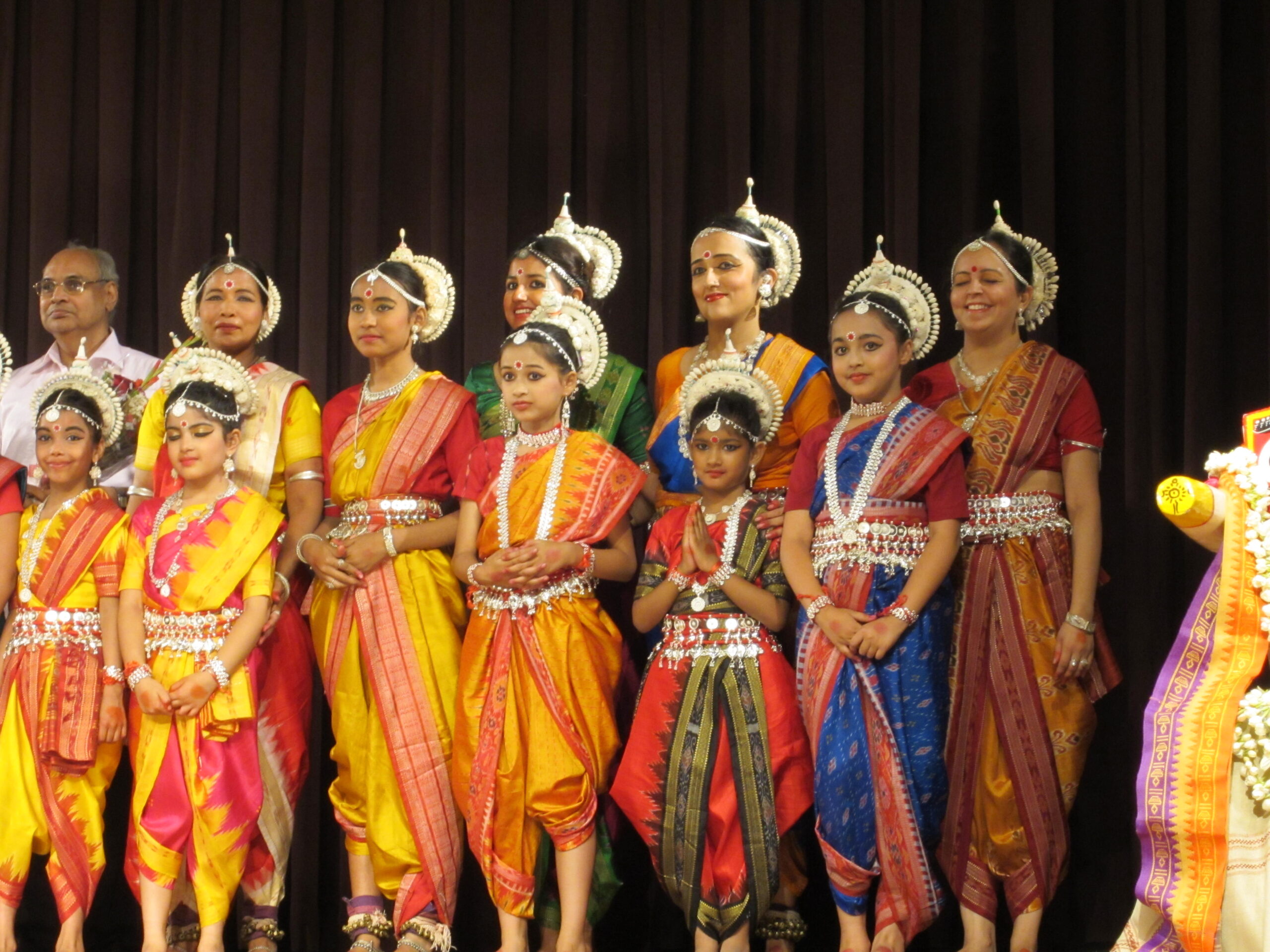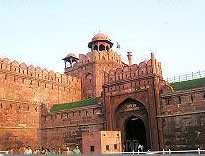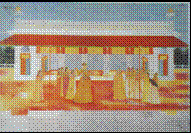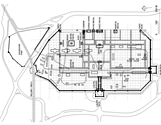Text of the paper delivered in the Seminar at the India International Centre on 13th April 2009
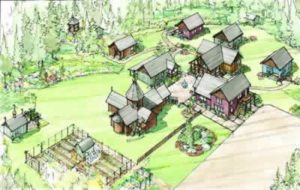
Architectural Sketch of The Monastery of The Russian Orthodox Church– serko.net
I would like to explore the role and relevance of liberal education in India today with my perspective of studying in nine schools in different parts of India, and my exposure to professional architectural study and practice. It is evident that our attitudes and our abilities as thinkers, policy makers, and politicians are inevitably shaped by the direction of the school education that we have received. As parents and teachers we orient our children to an unquestioning faith in ‘modern industrial’ technology and in a single-minded focus on jobs, so that most of them, like the post-graduate students to whom I teach ‘Research Paper’ in the Department of Industrial Design, grow up to be young adults with a stupefying belief that there are standard ‘correct’ solutions that they must ‘follow’. Conversely, I believe that architecture can be an important tool in tangibly communicating and making many aspects of basic education come alive, especially to school students.1 We may also draw direct parallels between school and architectural education – in both of which there are many things to teach, divided in different ‘subjects’ for ease of assimilation.
At first glance, formal architectural training as a specialized professional course dealing with the application of knowledge, seems to be far removed from the domain of liberal education as conventionally understood. However, if from the different definitions put forth, we consider Liberal as: ‘looking to the broad or general sense rather than the literal’2 such a criteria is already present in architecture – which is in a sense, a microcosm of different fields. This inherent strength of architectural education has been recognized in Italy. Though a small country, I am given to understand that at one time it had four institutions that taught architecture, each with ten thousand students. And what do these forty thousand graduates in architecture do? Only a fraction practice as architects or designers. The rest study architecture because they believe that it is the best education they can receive.
As undergraduate students at the well-known School of Planning and Architecture, we were taught many subjects, which left little time for leisure or boredom. Yet, practically all the emphasis was on transmitting skills or information such as: ‘how to draw perspectives, how to resolve issues of space and function in a building or a town, how to solve problems of load transmission in structures, how to describe the difference between North and South Indian temples, how to design with the principles of “modernist” architecture.’ And though the varied curriculum included art, science, and humanities, these disciplines did not tie up to a whole. I remember my inability to understand why we had to study sociology and the young Sociology Professor’s extreme discomfiture in trying to explain. Sociology was taught in isolation much like the joinery details which we planed and sandpapered in the carpentry workshop without ever using them to produce doors, windows, boxes or any object that demonstrated how they added up.
Also implicit was the contention that European or American ‘modernist’ methods of construction were desirable for students in India to learn, and that vernacular or classical Indian forms and spaces may be looked at as history, but have no place in contemporary architecture. As an instance, if we, after a study visit to the villages of Himachal Pradesh, visualized our designs in timber, this was lauded as an understanding of the context. But the timber details we were expected to follow were those standardized and set forth in British building manuals almost a hundred years ago, not local traditional wood details. Questions such as – ‘is the architecture we build appropriate to our culture, or is it elitist and redundant? Is there anything beyond the expression of our individuality and creativity that we need to consider?’ were posed sporadically, and more often in the student’s canteen than in the studios or lecture rooms. Today, they seem to have become even less of a concern than they were fifteen years ago. Thus, even with a scope of subjects that more nearly approaches ‘Liberal education’ than any other field of higher study, contemporary architectural training appears to comprise of ‘indoctrination’―a dangerous synonym of education―rather than fostering a discernment of fundamental principles and an engagement with ethics. Are these qualities relevant to architecture? This question, can be answered by looking at the environmental or climatic disasters that most contemporary buildings create today. The ornamental palms and stretches of lawn instead of the indigenous plants or shady trees that pass for landscape design; the size and form of cities which make them almost impossible to negotiate without the use of fuel-guzzling cars, the superficial and similar copies of popular international building trends – are all a reality before us.
Thus, it seems clear that though a wide-ranging curricula beyond narrow specialized information should find a place in technical, vocational and management education, this by itself is not sufficient. We also need to redefine the concept of ‘liberal education’ – which as we commonly understand is something bequeathed to us by the Western world. A wide-ranging study of the Classics, the Arts or the Sciences untainted by obvious motives of profit, may not necessarily make us adhere to the true meaning of Liberalwhich is defined as ‘willing to respect and accept behaviour or opinions different from one’s own’3 or to its synonyms of ‘progressive, tolerant, unbiased, enlightened, impartial’.
Did we have a tradition of liberal education in India before the advent of western education and can we draw any lessons from it? It appears that we did, at both a primary and higher education level. According to the research of the Gandhian historian Dharampal,4 even in ‘the greatly damaged and disorganized India’ of 1800, indigenous teaching was more widespread and vastly superior to that of the British. The physical environment under which Indian schooling took place was less dingy and more natural. The methods were effectual and economical. The composition of the students in schools was inclusive, with Sudras and lower castes predominating. Though higher education in Theology, Metaphysics and Law seems to have been dominated by Brahmins in the nature of professional specialization, other subjects such as astronomy and medical science were studied by scholars from a variety of backgrounds and castes. The results of research and study appear to also have been quickly disseminated in many sections of society.
This, in many ways indicates the existence of a more liberal society than that of present times. What are the shortcomings that prevent us from achieving such objectives today? Considered in the light of architectural education, these are, briefly:
- a method and content of teaching that is almost exclusively centred on a western modernist orientation, with a guiding principle that rejects the application of history as superfluous.
- an inordinate emphasis on dissemination of skills to the detriment of knowledge or issues.
- a stressing of abstract theories without encouraging their ‘application’.
- a fragmented, linear and compartmentalized way of learning that prevents overall comprehension.
Is there a paradox here? First we say, that specialization is an incomplete and therefore unsatisfactory way of looking at the world and dealing with it. Yet when we attempt to teach many things, we separate them into different subjects for practical reasons. Therefore, can there be only two situations―one, to know in great detail about only one subject, or two, to know about a great many subjects but still as separate systems of knowledge? Is this true of other fields of education in university/schools too? The answers may be forthcoming, if we look at some of the questions we need to ask, with respect to conventional formal education:
- How do we teach?
- What do we teach?
- Who do we teach?
- Who teaches?
In all of the above, the common feature at present is the attempt at standardization. We teach students without awakening a holistic interest in learning or linking back individual ‘subjects’ at the level of understanding different world views. We emphasise one single, standard way to design/way to research/way to cure as the only correct way, in direct contrast to the idea of the liberal. We use a syllabus that we standardize, rejecting ‘pre-industrial’ social, spatial, scientific or artistic systems as ‘backward’ without even knowing their features. We enroll students from a ‘standard’ economic and social stratum and we employ teachers of a ‘standard’ profile. As the noted scientist J.B.S. Haldane – who himself did not have a degree in science – reminds us ‘…Srinivasa Ramanujan, India’s greatest mathematician since Aryabhatta, had no degree and would thus be disqualified from teaching in an Indian University were he alive today’.5 If our efforts are aimed at promoting standard products who replicate ‘standard’ answers, then how can we expect creative, independent-thinking and responsive children or adults? It appears that the first step then is to reform this ‘standardization’, which at best insulates, and at worst divorces us from our local contexts. It neither fosters respect for others nor for the natural environment, and not even the knowledge of our own strengths and weaknesses, which is the real basis for self-respect.
School education today, particularly the CBSE, stresses isolationistic instruction of theory to the exclusion of application. Despite the experiments in playway education in some mainstream ‘progressive’ schools, children are inundated with theoretical information from the earliest years of school or at the latest by class four or five. Even in Environmental Science – a compulsory subject of late – the method of assessment is to test knowledge about organizations such as the World Wildlife Fund, rather than on helping students to understand the implications of everyday actions on the environment. The overriding emphasis today on computer-assignments as an educational tool, is a part of the same isolationist view which cannot apply the lessons of environmental science to other subjects and certainly not to daily life! As an illustrative example, here I would quote the experience of a progressive and famous public-school, which sought professional advice from a leading energy-institution on how to reduce cooling costs and make its new buildings environmentally appropriate. The advice that the school received was impressively detailed and voluminous, with results from high-technology monitoring equipment and insulating techniques. But it incredibly did not mention the basic fact that the North-South orientation of the proposed buildings was incorrect, and till this was corrected they would inevitably absorb maximum heat! This reveals the absurd ‘blinding’ that such technocratic and isolationist attitudes breed.
How should our education, technical, vocational or otherwise, remove such a ‘blinkered’ vision? Dr Zakir Hussain wrote an article in 1961 in the journal Nayee Talim,5 which may summarize all the objectives of a truly liberal vision for centers of education, ‘To train students for taking responsibilities of various social tasks…to expand the areas of knowledge…to include broad-mindedness in its students, to inspire the students to live a life of goodness and truth’. Thus, the national goal of education, whether we call it ‘liberal’ or anything else, should first open a method of enquiry for its students to judge situations, to formulate their actions, to evolve into good human beings, not to produce individuals whose sole aim is to earn more. The world is not standardized, it has unique solutions to different situations, which despite being different are all linked, and affected by all actions, great and small. The only way to understand the world is through self-realization which may begin with, but does not end, with formal education.
Is it possible to do all this by being primarily dependant on western systems of living and learning? No. Segregation and fragmentation, specialization and confrontation were inherent parts of the method of inquiry in the western tradition even before industrialization put this into more glaring view. As Chaturvedi Badrinath writes in The Mahabharata An Inquiry Into the Human Condition, a look at the history of philosophical thought in the West shows that ‘…when systematized into an ism, the various explanations of the human condition had fiercely rejected each other…But although fiercely rejecting each other, all these isms have one thing in common – a logic which fragments human attributes into irreconcilable polarities, and then assumes either the one or the other is the reality, and constructs its world view wholly on that, or the logic of either/or’.7
In fact, unlike much of western thought, indigenous methods of inquiry seem to lend themselves more easily to holistic and wholesome attitudes to learning. The difference between these two world views – the exclusionary and the inclusive – is manifest in the answer of some Brahmins three centuries ago. Asked a question on a subject as personal and emotional as religion, by the French traveler Francois Bernier, this is what they had to say:
‘We pretend not,’ they replied, ‘that our law is of universal application. God intended it only for us, and this is the reason we cannot receive a foreigner into our religion. We do not even say that yours is a false religion: it may be adapted to your wants and circumstances, God having, no doubt, appointed many different ways of going to heaven.’
Bernier on the other hand, could not understand this point of view. And this is what he had to say: ‘I found it impossible to convince them that the Christian faith was designed for the whole earth, and theirs was mere fable and gross fabrication’.8
So how does all this translate into education today? Does it mean a change in the method of teaching? In the content? In both? In our present assessment and evaluation procedures? Practical demands of time, space and resources imply that there will be some amount of specialization as one proceeds on the learning path, and it would never be possible to teach everything about everything. We must also recognize that in the learning curve of individuals, society and civilization, some amount of specialization is the natural path of evolution. A Benarasi weaver whose remarkable skill and creativity we treasure as heirlooms, does not learn pottery or till the land. Were he to do so, he would have neither the time nor the skill to fashion his intricate weaves. Yet, this specialization does not divorce him from his natural or cultural context or knowledge base. He traditionally operates within a societal framework, which creates a need for his skills and which provides him with sustenance to develop these. Today, such a societal and cultural framework is missing. It can only be regenerated if even in specialized training at any stage of education, the emphasis is general, and the composition of our curricula and our teachers is inclusive. Colleges in their dissemination of specialized education must encourage students in theoretical and practical instruction, which is balanced and engages with cultural and social issues. Such holistic education would help students obtain a more complete understanding of the world, and avoid mindsets like Bernier’s that reject everything unfamiliar, as false or untrue.
How shall we practically achieve this? By completely rejecting western systems of education or thought? By limiting study to only indigenous traditional systems? Certainly not, since that would be continuing the same exclusivist view that is the main deficiency of our education today. All education must develop an enjoyment of the process of learning, and an engagement with the natural world. The analogy may be likened to a baby, whose first efforts are aimed at resolving the objects seen, heard or felt in the immediate vicinity. This is how we are genetically coded to grow. A knowledge of local systems and sympathy with the natural world, will help to comprehend larger systems or those from other regions or cultures. As Winin Pereira clarifies in his book From Western Science to Liberation Technology, ‘It is the traditional methods of research, development, dissemination and use that are still relevant, not necessarily all brought forward pieces of knowledge’.9 Thus, primacy to indigenous traditional systems of learning in formative years, should help, not inhibit enquiry and direct experimentation in other systems–whether non-indigenous, non-mainstream, conventional or unconventional. The spirit of inquiry and analysis can be furthered and coupled with an understanding of the universal and natural worlds, to eventually lead to creative, contextual, humane theory and practice.
Thus the policy formulation with regard to liberal education should be that:
- Theoretical instruction instead of remaining abstract,must link learning to real life, illustratedthrough stories and examples(most people, especially children love stories, and these are invaluable in explaining even complex notions of philosophy, conduct, etc. as the Mahabharata and much of our traditional literature demonstrate).
- The proportion of practical instruction must be increased,and must connect to nature. Students should be encouraged to work with their hands, and learn by ‘doing’ so that satisfaction and a sense of achievement are the incentives to learn, not marks.
- Both theoretical and practical instruction, must include dissemination and discussion on traditional and indigenous knowledge, through an active involvement of non-mainstream disciplines or cultures – such as folk artists, craftspeople, writers in indigenous languages – rather than just conventional academics and theoreticians. Educational experiments, such as the one where a flower-seller and her five year old daughter, were instructors to Class Six students in the Padma Seshadri Bala Bhawan in T. Nagar in Chennai for three days,as reported inThe Hindu, should be widespread.10
- There should be an optimum size beyond which the classroom and the educational institution must not grow. Large sizes and centralization necessitate standardization for ease of management, consume greater resources, and take away the emphasis from learning to administration.
- The present system of evaluation,based on marks must be replaced by one based on grades.
It is not as if these problems or the suggestions offered have not been recognized or enunciated before our time. The experiments in school and college education at SriNiketan and Santiniketan by Rabindranath Tagore and in national education as envisioned in Mahatma Gandhi’s NaiTalim, did this almost a hundred years ago. Why have these experiments failed? Why they been largely forgotten or sidelined by mainstream education? If individuals of such political, intellectual and moral stature such as Tagore and Gandhi were unable to make a difference despite actually setting up schools and universities that applied visionary principles, is it likely that we will be able to do so? Even today, there are some institutional and private efforts committed to unconventional or non-formal methods of learning. The reason that these efforts were and are unable to make a dent in society or permeate through larger sections of it, is largely due to the Government’s unwillingness to promote these as valid ways of learning. This sort of education does not fit the official notion of development. The idea of development as perceived by the government is still the Nehruvian one which in essence is the western industrialized model, a model which as argued earlier is incapable of accepting, like that of Bernier’s mindset, any other path to an alternative development option. Therefore, the only way for a change to happen, is for the Government, as the overall authority responsible for running the country, to realize that the present notion of development is flawed. It must, as must we all, recognise the necessity of liberal education and endorse holistic teaching and evaluation methods. Rather than setting up new competing institutions, we need to transform our existing institutions at every level and decentralize. This implies a great deal of consensus-building through interaction, discussion and cooperation which is no doubt difficult. But it is not impossible.
In my teaching of Research Paper, by no means sufficient in providing complete answers – especially when compared to the work of more experienced educationists – there has been a partial success in the students’ ability to link abstract design and real social issues or to express themselves openly with conviction. Most of the students comprehend that the state of the urban poor and homeless in our cities today, are as affected by the disappearance of traditional livelihoods as with the plastic or metal products designed such that they can only be made in large mechanized factories. The students also realize that ostensibly beneficiary schemes of large-scale export of handicrafts may actually hasten their extinction by promoting standardized production possible only in ‘factory-like’ situations. However, the focus of their lessons in other subjects or in design studios, even when actuated by themes such as ‘socially relevant design’ invariably leads them to modern, mechanized engineering industrial designs. Their site visits are to factories or large multi-national firms where they foresee themselves working in the future, not on an apprenticeship with master-craftsmen. Most typical urban professionals feel they have no other option, since alternative choices do not eventually assure them of economic security. Here again the government has a larger role to play, not in terms of subsidies or grants, but in recognizing indigenous economic structures as valid, inclusive and wholesome. This would be therefore “in-sync” if the government-supported education system would become more holistic.
I would like to end with a quote from Harsh Mander in an article on a different context, but which I believe can be a guide to what we hope to achieve from this seminar, or indeed any action we do, any work we contemplate, any change that we envison, whether in education or in life: ‘Gandhi offered us a “talisman” to use in moments of doubt and confusion. He asked us to recall the face of the poorest, most defenceless, powerless man we have encountered…We must ask ourselves whether what we are attempting has meaning for this person.’11
Acknowledgements;
The ideas expressed in this paper have been greatly clarified and extended by discussions with many people, particularly Snehanshu Mukherjee and Badri Narayanan, both insightful architects committed to teaching and learning. The experience and attitude of Chitra Dhariyal and Madhu Pandey, in dealing with the challenges of teaching secondary and high school students, and the optimism of the artist and writer Shakti Maira, transmitted as much in his conversation as in his writing about art and education, have made me rethink notions about how I deal with the development of my five year old daughter as well as my methods of teaching college students. Finally, I believe that we can only find answers to many of our challenges in education today, even in this greatly changed and changing world of the 21st century, if we look at the life and work of Mahatma Gandhi and Rabindranath Tagore, and many others of their generation.
Notes:
- Architecture gives an insight into the living conditions, methods and materials of construction, concepts of time and culture of previous generations. In fact, some countries in the world are already experimenting with using architecture as a tool for teaching school children.
- Chambers Dictionary
- Oxford Dictionary and Thesarus (Indian Edition)
- Dharampal, The Beautiful Tree, Indigenous Indian Education in the Eighteenth Century, First Published by Impex India 1971, Republished 2000 by Other India Press, Goa, in association with SIDH Society for Integrated Development of Himalayas, Mussoorie
- As quoted in Rabindranath Tagore, Philosophy of Education and Painting, Devi Prasad, National Book Trust, India, Creative Learning Series, First Edition 2001, New Delhi
- The Hindu Tuesday, April 7 2009, ‘Polymath who shared the fun of science’, Vidyanand Nanjundiah.
- The Mahabharata An Inquiry Into the Human Condition, Chaturvedi Badrinath, Orient Longman 2006, p.10-11.
- Francois Bernier, Travels in the Mughal Empire, p. 328
- Winin Pereira, From Western Science to Liberation Technology, Earthcare Books, Kolkata, first edition 1993
- The Hindu Tuesday, April 7 2009, ‘The hands that craft and create’, Priscilla Jebaraj. The report also mentions that CBSE has already worked out a syllabus in handicrafts for an elective course in Classes 11 and 12.
- The Hindu Sunday April 5, 2009, ‘BAREFOOT, The silent tragedy of hunger’.

